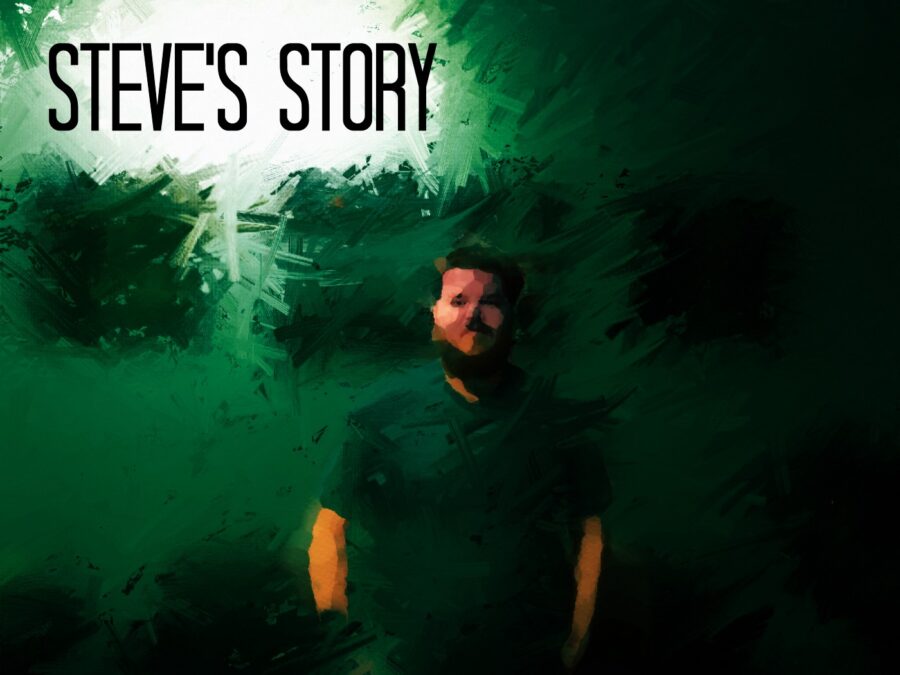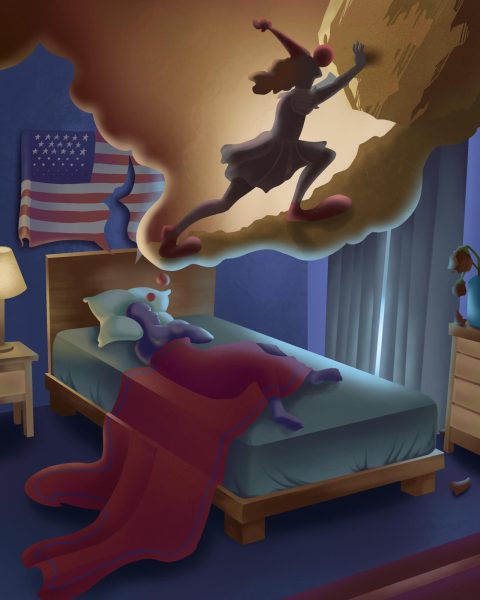Depression and the Lives that Might Have Been
An in-depth look at a father’s experience with mental illness, child-loss, and the struggle to find hope. Dedicated to those who have been there and those seeking understanding. You are not alone.
“I was sitting there with a gun in one hand and a bullet in the other, and just running a mantra through my head of ‘load the gun, pull the trigger.’”
Steve, 30, sat on the edge of his bed. The collector’s edition World War II rifle, which weighs about eight pounds, pressed into his left thigh, and the neck of the gun extended past his shoulder. He felt the oil from the gun’s recent polish against his fingertips. The words, which began as a gentle whisper, grew in intensity: Load the gun. Pull the trigger. Load the gun. Pull the trigger. In his right hand, he held a single bullet — stockpiling the nerve to commit suicide.
Anger, guilt, frustration, and sorrow immersed him, forging a devastating internal battle. His self-esteem was heavily wounded. He was already tired and had gone to take a nap when he overheard his wife’s voice in the kitchen. She was talking to his mother-in-law and venting her frustrastions and concerns about him — his mood swings, which seemed to be getting worse, was a particularly sore topic for him. Her words resonated with him, and he felt as though he was being a bad husband and a bad father. It was an emotional cord years in the making.
A few years prior, Steve was diagnosed with cyclothymia — a lower level of bipolar disorder, characterized by mood swings between depression and elation. Steve recalls having manic and depressive mood swings multiple times in a day, which worsened with stress.
During his depressive mood swings and aggravated states, Steve also felt pressure to maintain his daily routine, which included completing paperwork and meeting deadlines for both his business and his classes. The stress of daily activities caused him to snap at people and spiral through feeling aggravated, then depressed, and then feeling angry again.
“I would go to feeling really depressed and just feeling like I couldn’t do it and wanting to give up, and then I would get angry again. And I would just fluctuate back and forth like that, for a long time, so I wasn’t a very pleasant person to be around,” said Steve.
While in an aggressive mood state, he’d snap at people, and while in a depressive state, he’d struggle with feelings of hopelessness, but this was his darkest episode. He wasn’t only feeling hopeless. He was actively planning to end his life.
He convinced himself that his one-year-old daughter and wife, who was in the early months of pregnancy with twin girls, would be better off without him. He reasoned that it would be better if he was gone before the girls were old enough to remember him — or his mental illness.
For five or ten minutes after hearing his wife’s frustrations and concerns, he stayed motionless in his bed. Negative self-talk continued to grip him, dragging him further into the depths of intense depression and suicidal ideation. Mentally, he rehashed old fights and inadequacies — burried as a root cause of much of his emotional turmoil is a failed legal battle with his mother, which often triggered his aggressive mood swings.
According to PsychCentral, a trigger is something that sets off a memory tape or flashback transporting the person back to the event of original trauma. For Steve, his mother was the trigger, and any association with her ignited an intense emotional upset for him.
Once triggered, Steve wouldn’t really throw anything or become violent, but he’d angrily pace back and forth, yelling and ranting at no one in particular to vent his frustrations. Although his yelling was frequently to the walls, furniture, or the open air, his emotional intensity would radiate and was nearly palpable to those in the vacinity. His daughter would begin crying when she sensed his anger building.
“It had gotten so bad that my mom could just try calling me on the telephone, and I would just see her caller ID pop up, and I’d immediately start going into a rage,” said Steve.
His rages could be triggered while at home or at work — transporting him back to memories of a legal battle he’d fought and lost against his mother, whom he had attempted to gain conservatorship over — the legal right to care for an adult who cannot take care of themself, or who cannot manage their personal finances.
In the case of Steve’s mother, he was fighting for conservatorship in an effort to take on responsibility and do what was in the best interest of his mother and the family. His mother had a brain injury in which she lost a third of her brain before he was born, and she was also diagnosed with bipolar disorder. According to Steve, her medical condition caused her to have erratic spending, erratic behaviors, and to “generally cause trouble for the family.”
Perhaps the greatest trouble for Steve was that the stress of the legal battle triggered the onset, or exasperation, of his own mental illness, and showcased the genetic component of mental illness to him. A month or two after having lost the fight to assume legal responsibility for his mother and her estate, Steve began experiencing an increased inability to focus on daily tasks or handle his emotions. Because of his understanding that Bipolar is a genetic disorder, as a father, he feared triggering the disorder in his children:
“I didn’t want to be a negative influence in my daughter’s life, like my mother had been in mine — you know, of just dragging everyone down,” said Steve.
As his pregnant wife and one year old daughter shuffled out of the apartment en-route to the store, Steve entered one of the darkest times of his life. Lying there in that moment, the furry of his rages and rants was turned inwards, directed at himself for all he wished to be and do, and all he feared he’d never accomplish. His mind and emotions whirrled.
In his emotional anguish, he was convinced that he wasn’t capable of being a good husband, that he would become a bad father, that he was a disappointment to those he loved most, and that sadness, that feeling of hopelessness and lack of purpose and validity as a human being began to transform into a desperation to do right by his family. Combined with a twisted belief that they would be better-off without him and an underlying psychological need to feel control amidst internal chaos, the dangerous mantra began building in Steve’s mind.
Within minutes of peak emotional despair, the emotions began to separate and Steve subconsciously dissociated, splitting the weight of his emotions from the act of killing himself. Emotionally, he became almost numb and began thinking about the way he would end his life in technical, logistical terms — as if killing himself was a task on a to-do list.
His thoughts became calculatory. Where he would sit and which wall, or direction he should face when he pulled the trigger were conscious thoughts of his. He didn’t want to harm anyone else with a wayward bullet. There was a tenant living on the floor above him. He heard the footsteps moving around from time to time and feared the possibility of using the wrong angle and having the bullet penetrate the ceiling and injure his neighbor upstairs. His apartment was on the first floor, and he was also mindful of not wanting the bullet to fly through a wall or window near a walkway in which a passerby could be harmed.
He was transfixed on the details of completing the task. He chose a wall which had an empty courtyard at its back, and considered what would happen to him physically.
The imagery of how the bullet might penetrate his skull and open the backside of it up like a split banana peel was instilled in him from his first gun-training safety-lessons, at 14 years old. He vividly recalled the way his Scout Master demonstrated the impact of guns on a propane tank. The loud noise and ten inch hole through the center of the contorted metal tank sent a clear lesson to him: Never point guns at friends, family, or people — it’s dangerous; guns destroy things.
He knew the danger. He knew the potential of a ricocheted bullet passing through ceilings, floors, walls — he knew he didn’t want to hurt anyone else, and in his mind this was about preventing further hurt, for himself, but mostly for his family. He didn’t want to disappoint them anymore.
He thought in terms of “had to’s” — “I had to get the keys. I had to get the gun. I had to unlock the trigger lock.” In his mind this was something he “had to do.” It was something he had fantasized would relieve his family of the disappointment and frustration he felt he’d caused them. It was a plan he’d rationalized to unburden them of him — a plan that seems logical to a mind burdened with mental illness and uncontrolled emotions.
He didn’t give much thought to what the impact would be on his family, in negative terms. He hadn’t focussed on who might find his body, or how traumatizing and emotionally devastating the effect could be for his loved ones. While he knew the mechanics and the power that a riffle has to devastate a human body, he hadn’t focused on the clean up — the gory details of who would have to scrub his blood or bits of his mangled corpse from the walls, flooring, and personal items in the bedroom.
He hadn’t deeply considered the quality of life he might have if he attempted suicide and fell into the twenty-five percent who survive self-inflicted gunshot wounds to the head — the potential for horrible disfigurement, a life of feeding-tubes and reconstructive surgical attempts, or the trauma the event could cause for his pregnant wife, who also struggles with depression, and the negative ramifications of a daughter growing up with the knowledge her father committed suicide. These were ugly bits his mantra skirted around.
“Load the gun, pull the trigger,” steadily replaced thoughts of disappointing his wife and worries that he would disappoint his daughter. It lulled him into focussing on a narrow, situational problem-solution orientation. The mantra channeled his emotionally-overwhelmed constitution into, as simple of, an “effective” plan as he could muster. The moment had built in his mind. The preparations had been made. He’d chosen his wall. He sat gripping his gun. He’d braced his heart for good-bye. He could feel the words with building intensity. The blood coursing through him, the words growing louder — the chaos to come to an end. He was ready, and he knew the gun worked.
Load the gun, pull the trigger.
Moments away from ending his life, he heard the keys of his wife approaching to open the front door. The sound of her coming back into the apartment, possibly to grab something she’d forgotten, snapped him out of the dangerous trance he was in. He quickly tucked all evidence of what he was about to do out of site, just as she stepped through the door.
“It was just getting interrupted that had caused me to put everything away.”
Once interrupted, he tried to act as if things were normal. It almost worked. No one knew how close he had come to recreating the damage that he’d seen on an empty propane tank on his own head, but shortly after his intense depression and strong suicidal ideation, Steve’s mood was on the upswing, changing in the polar-opposite direction. He became manic — and it wasn’t something he could hide. He was frantically energetic, irritable, and behaving strangely. He decided the only thing to do now was run.
He left as if to go to work, but didn’t get very far. Steve was overcome with the feeling that he had to go, to get out of there, to just disappear. Unsure of where to go, he stopped by his office to grab a few things at work, planning his escape, but there were a few things he had to take care of once there — paperwork, checking the mail, routine tasks to ensure business continued. Eventually, in the middle of the night, he calmed down and decided to return home. He came back with such intensity and energy that his wife was alarmed and frightened. They fought.
In a torrent of bitter words and weighted emotions, his wife wanted him out of the house and away from the family until he got himself together. His condition threatened the strength of their bond. She questioned if she could trust him because of his volatile temper. She even feared him capable of hurting her or their little girl.
“I hadn’t ever done anything of a nature to hurt them, but my wife’s dad would sometimes get a little physical when he became upset, so she was afraid that I might do something similar,” said Steve.
Like a ball of thread, his ability to hold things together at all began to unravel — work, school, his mood, his relationships were all being affected. Steve left home and was away from his wife and daughter for about six months. During that time, he went to live with his father.
Slowly the gravity of his mood swings bore into him. If his wife hadn’t returned in that exact moment, he would have killed himself:
“If I hadn’t heard her walking up, it probably would have happened right as she walked through the door, a couple moments later.”
This powerful realization convinced him there was a problem. He wanted to be a good husband and a good father — and he knew he needed help regaining emotional stability, but it was still a challenge.
“After that, after I was kicked out, I started to try to find help, because I really needed mental help… so I started searching online, and that’s when I found DBSA.”
DBSA, which stands for “Depression, Bipolar, Support, Alliance,” is a mental health, peer support group. The group is designed to be a safe place in which those struggling with mood disorders can openly discuss their experiences within a supportive environment. DBSA also provides resources and group activities to encourage healthy, positive social interactions as an alternative to the proclivity to socially isolate while feeling depressed.
“DBSA showed me how to get the help that I needed, in an environment where people could say ‘I tried this — and here’s what happened,’ and someone else could say, ‘well ask them to try this instead,’ and so DBSA has been a really big help to me.”
For Steve, DBSA was the source of encouragement he needed to get involved in a hospital out-patient program. Prior to that, the horror stories he’d heard of negative hospitalization experiences related to mental illness had dissuad him from utilizing the resource. Through DBSA, he heard member stories and struggles with his condition and how getting help had positively changed their lives. He learned which questions to ask and which things to suggest to his psychiatrist, all with a supportive, non-judmental tone.
He was among people who had been there, gone through the same darkness of depression, and they understood and encouraged him in a profound way — he wasn’t alone in his struggle, which helped him to overcome the necessary hurdles on his path to emotional wellness: “I wasn’t too enthused about taking medication. It was one of those cases where I knew I needed to take medication, but I didn’t really like it,” said Steve.
While Steve wasn’t thrilled about the process of testing out different medications, adjusting dosages, and finding a balance of chemicals that worked for him, he knew it was something that he had to do in order to return to his wife and daughter. His family was growing, his wife expecting twins, and he wanted to grow along with his family, so he began taking the necessary steps with a new resolve to be better, and each support anchor that he gained furthered this resolve.
The pieces were slowly coming back together. With his new support systems in place, things began to mend in his relationship with his wife and daughter. Things weren’t perfect, and his medication was still in the process of fine-tuning, but things were starting to improve. He was taking a break in his education, and only did the necessary work to maintain his business, so he had time to focus on his wellness.
He switched focus as his wife’s due date was quickly approaching. Steve and his wife began to busily focus on the twin’s arrival and making sure that everything was ready.
They had begun buying everything in pairs and even had two carseats in anticipation of bringing the girls home. Eight months into the pregnancy, routine doctor appointments had all gone well. When suddenly, his wife felt something was wrong. They returned to the doctor to find the twins no longer had heartbeats.
“We had gone to the doctor one day, and then the next day, they were gone.
The doctor had given them a clean bill of health and everything, but something happened. The blood flow had gotten cut off, and by the time my wife and I had realized what had happened, they were gone.
And it was one of those things that if we had known the day before that something could happen, then they could have been saved.”
The impact of losing the twins eight months into the pregnancy weighed heavily on Steve for a long time, but he did his best to be stronger for his wife. His strength ebbed and flowed. Steve described his experience as “a battle of both wanting to increase his resolve to fight for his family and wanting to give up.” He credits the support of DBSA and a medication adjustment that happened just before their loss to getting him through it.
“I was fortunate enough at the time that I had actually had a medication adjustment right before, prior to …and it got me through it, so that I could be a rock for my wife while she was going through it, so I was able to have the resolve of:
‘I’m going to be there, and I’m going to be supportive, and I’m going to be as well as I can to get us through it.’
But it also made me really sad, and then I would be depressed, so I would go through periods where I could be that rock, and I could be really supportive, but I’d also go through periods where I would just be depressed and not able to do anything.”
During the saddness of depression, Steve also used to turn to marijuana in order to escape negative feelings.
“For relief, it wasn’t a good thing to do, but I turned a lot to marijuana. It made me not care about things… It kind of numbs me enough to what was going on, so that I could just get through it,” said Steve.
Turning to alcohol or substance use is common with mental illness as a form of self-medication. According to an article on the dual diagnosis of depression and drug addiction, “many depressed individuals reach for drugs or alcohol as a way to lift their spirits or to numb painful thoughts. As a result, depression and substance abuse feed into each other, and one condition will often make the other worse.”
The same article also cites the Journal of Clinical Psychiatry as reporting that “one in three adults who struggle with alcohol or drug abuse also suffers from depression,” showing the interconnectedness of depression and substance abuse.
While substance use is a common go-to form of escape, or means of self-medicating, it can cause complications with medical treatment options, and can even worsen the severity of mental health symptoms. In Steve’s search for wellness, he had to ultimately give up marijuana as a coping mechanism.
While in an out-patient program at Las Encinas, he had a doctor that wouldn’t treat him while he was using marijuana, so he stopped using it, which was “difficult” for him:
“It was difficult. It didn’t feel like a step forward at the time because I was giving up my coping mechanism, and not really happy about it, but my moods have been more stable since giving it up.”
Even though it was difficult and there are still times when he wished he had it, for Steve, marijuana was an added variable in the equation of finding his medication balance that he didn’t need. Because his psychiatrist would have stopped seeing him if he didn’t stop using it, he decided to focus on finding other means of coping and continues to do all that he can to be there for his family, which is his bigggest source of hope and motivation.
After losing the twins, Steve and his wife slowly began to donate the duplicate items. They kept one of each with hopes and plans to have another child in the future. For now, Steve and his wife focus on managing their conditions, supporting each other, and being the best parents they can be to their little girl.
“It’s been a tough year since losing them for both my wife and I. I was in out-patient therapy at the time, so I ended up having a lot of therapy on it. My wife took it harder. She didn’t have that support, and it’s been very difficult for her for the last year. We’ve just tried to be there for each other, and just do the best that we can.”
Steve invited his wife to DBSA with him, but she preferred that be his safe place. She tried attending a support group for mothers who have lost their infants, but, “for various reasons, it didn’t work out,” according to Steve, who said he had a hard time pushing his wife to get the help that she needs, but that she is now seeing a therapist and taking medication, as well.
As a father, the hardest part about having a mood disorder for Steve has been that there are times when he just wants to be alone and feels he can’t be there for his daughter. Then there are times where he feels great, and he’s there for her: “I’m not as good of a father as I’d like to be, but I try to be as good of a father as I can be,” said Steve.
Luckily, his daughter seems to be really understanding.
“She understands that Daddy is sick, and that there are times when Daddy is fun, and then there are times when Daddy just needs to be left alone.”

Having the support of DBSA, his wife, and the understanding of his daughter has given Steve hope.
“It’s my family that gives me hope. I want to be there for my family as best as I can. That’s why I’m doing everything that I can to be as well as I can, to be there for them — I’m glad that I’m here because I ended up getting the right treatment eventually. It took time, but I’m definitely glad to be here.”
Through everything that he has been through, Steve continues learning what works for him, focusses on doing his personal best for his family, and focusses on a positive perspective for the future. For those going through hardships, similar or otherwise, Steve offers the following insight:
“I just call it a journey. There’s not really a quick fix. It just takes time.”








